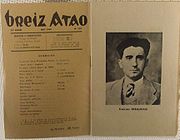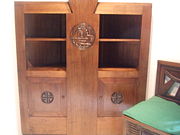
François Debeauvais
Encyclopedia

Breton nationalism
Breton nationalism is the nationalism of the traditional province of Brittany in France. Brittany is considered to be one of the six Celtic nations...
and wartime collaborator with Nazi Germany
Nazi Germany
Nazi Germany , also known as the Third Reich , but officially called German Reich from 1933 to 1943 and Greater German Reich from 26 June 1943 onward, is the name commonly used to refer to the state of Germany from 1933 to 1945, when it was a totalitarian dictatorship ruled by...
. His name is also spelled in many "Breton" variants: François Debauvais, Fransez Debeauvais, Fransez Debauvais, Fañch Debeauvais, Fañch Debauvais, Fañch deb.
Breiz Atao
Debeauvais was the son of a gardener from Le PertreLe Pertre
Le Pertre is a commune in the Ille-et-Vilaine department in Bretagne in north-western France.-Demographics:Inhabitants of Le Pertre are called Pertrais.-References:* ;* -External links:* *...
. Initially he worked as a pharmacist, but soon became an activist for Breton nationalism. He was associated with the founding of Breiz Atao
Breiz Atao
Breiz Atao , was a Breton nationalist journal in the mid-twentieth century. The term is also used for the broader movement associated with the journal's political position....
(Brittany Forever), the Breton nationalist journal. He was named president of Unvaniez Yaounkiz Breiz, the Breton nationalist youth wing, in 1920. He quickly rose within the movement, becoming associated with the faction of Yann Bricler, and Olier Mordrel
Olier Mordrel
Olier Mordrel is the Breton language version of Olivier Mordrelle, a Breton nationalist and wartime collaborator with the Third Reich who founded the separatist Breton National Party. Before the war he worked as an architect. His architectural work was influenced by Art Deco and the International...
. He took part in Breiz Ataos Pan-Celtic Congress in Quimper in 1924, with Yann Sohier, Youenn Drezen
Youenn Drezen
Youenn Drezen is the Breton language name of Yves Le Drézen, a Breton nationalist writer and activist. He is also known as Corentin Cariou and Tin Gariou.-Youth:...
, Jakez Riou, Abeozen
Abeozen
François Eliès, born Fañch Eliès and better known by the pseudonym Abeozen, was a Breton nationalist, novelist and dramatist who wrote in the Breton language. Abeozen was also a noted scholar of the Welsh language.Abeozen started contributing to the Breton literary journal Gwalarn in 1925...
and Marcel Guieysse. According to the memoirs of his wife Anna Youenou (a fellow member of Breiz Atao
Breiz Atao
Breiz Atao , was a Breton nationalist journal in the mid-twentieth century. The term is also used for the broader movement associated with the journal's political position....
, who he married in 1929) he was much influenced by Charles Maurras
Charles Maurras
Charles-Marie-Photius Maurras was a French author, poet, and critic. He was a leader and principal thinker of Action Française, a political movement that was monarchist, anti-parliamentarist, and counter-revolutionary. Maurras' ideas greatly influenced National Catholicism and "nationalisme...
at this time. In 1930, he proposed the creation of a major weekly magazine to be called Le Peuple Breton (the Breton People), but was unable to secure sufficient funding.
Breton National Party
With the split in Breton nationalism between federalists and independentists, François Debeauvais supported the latter and joined the newly formed Breton National PartyBreton National Party
The Breton National Party was a nationalist party in Brittany that existed from 1931 to 1944. The party was disbanded after the liberation of France in World War II, because of ties to the Nazi party....
. He continued as editor of Breiz Atao. He was also connected to the Gwenn-ha-du
Gwenn ha du (terrorism)
Gwenn ha Du was a Breton-based terrorist group founded at the end of 1930 in Paris by Célestin Lainé. It advocated Breton nationalism through "direct action" and published a secret manual aimed at instructing readers in terrorism...
, the terrorist wing of the movement.
In March 1933, Breiz Atao published a programme named "SAGA" (Strollad Ar Gelted Adsavet: Programme of Revived Celts), which was worked out by Mordrel. Debeauvais was careful to present it as a proposal for the direction of the party, not as its policy. The fascistic and racist nature of Modrel's programme provoked criticism from many readers. In 1937, Debeauvais prevented Mordrel's extremist faction from seizing the power within the PNB.
Nevertheless, Debeauvais's views had much in common with Mordrel. During the late 1930s, both men forged links with the Nazi party. As World War II
World War II
World War II, or the Second World War , was a global conflict lasting from 1939 to 1945, involving most of the world's nations—including all of the great powers—eventually forming two opposing military alliances: the Allies and the Axis...
approached, the French government sought to prosecute him for seditious activities. After a period in exile in Belgium, Debeauvais was imprisoned for 6 months. On December 14, 1938 he and Mordrel were condemned to a further term for "attacking the unity of the nation". He was released on July 25, 1939, after apologising on February 15, 1939.
Exile in Nazi Germany

Édouard Daladier
Édouard Daladier was a French Radical politician and the Prime Minister of France at the start of the Second World War.-Career:Daladier was born in Carpentras, Vaucluse. Later, he would become known to many as "the bull of Vaucluse" because of his thick neck and large shoulders and determined...
. The party's property was confiscated and files destroyed; Debeauvais and Mordrel chose to go into exile rather than support France. From Amsterdam, Mordrel and Debeauvais addressed a proclamation to Bretons, condemning the war.
By the end of 1939 he had moved to Berlin "to try to play the card of Breton independence in the probable outcome of French defeat".
In Germany, the Pangermanist faction recommended the extension of the Reich to all the German-speaking populations and the dismantling of the great European powers according to linguistic criteria, a view consistent with Breton nationalism. The creation of a Breton State also found supporters among militarists who wished to break up France so that it would no longer rival Germany.
In January 1940, Debeauvais and Mordrel drafted a "War Letter" (Lizer Brezl) to their militant supporters, insisting that "a true Breton does not have the right to die for France". They added, "Our eternal enemies and our present ones are the French, it is they who have never ceased to wrong Brittany". In April 1940, in imitation of Roger Casement
Roger Casement
Roger David Casement —Sir Roger Casement CMG between 1911 and shortly before his execution for treason, when he was stripped of his British honours—was an Irish patriot, poet, revolutionary, and nationalist....
, he devised a project of unloading arms from a submarine on the coast of the Leon, to allow him to reconstitute the Breton National Party as a secret paramilitary group. He abandoned the plan after Mordrel intervened.
On May 7, 1940, he and Mordrel were tried in absentia by a military tribunal at Rennes for "attacking the external safety of the State and the integrity of the territory, maintenance or recruitment of a dissolved group, provocation of soldiers to desertion and treason". They were degraded militarily and condemned to death. At the beginning of May 1940, Debeauvais declared in Berlin a Breton "government in exile" (Bretonische Regierung). It was not however officially recognised by the Nazis. Nevertheless, the Nazis gave Debeauvais and Mordrel "stateless persons" passports, and sympathisers within the German secret service allowed them to travel freely.
Debeauvais returned from exile to France along with the victorious German army in June 1940, arriving in Brittany on July 1. Later in the month, at the "Congress of Pontivy
Pontivy
Pontivy is a commune in the Morbihan department in Brittany in north-western France. It lies at the confluence of the river Blavet and the Canal de Nantes à Brest.-History:...
", Debeauvais and Mordrel created the Breton National Committee
Breton National Committee
The Breton National Committee was a Breton nationalist body founded on July 3, 1940 at the so-called "Congress of Pontivy", headed by François Debeauvais and Olier Mordrel. It was designed to promote Breton independence from France by collaboration with the occupying German forces. They drew up a...
. They also founded a new journal, L'Heure Bretonne
L'Heure Bretonne
L'Heure Bretonne was a Breton nationalist weekly newspaper which was published from June 1940 to June 1944. It was the organ of the Breton National Party and was strongly associated with collaborationist politics during World War II....
to replace Breiz Atao. 201 issues appeared between July 1940 and June 1944. Its first editor was Morvan Lebesque
Morvan Lebesque
Morvan Lebesque , was the Breton language name of Maurice Lebesque, a Breton nationalist activist and French journalist....
.
Illness and death
In October 1940, Debeauvais's health suddenly worsened. He was diagnosed with tuberculosisTuberculosis
Tuberculosis, MTB, or TB is a common, and in many cases lethal, infectious disease caused by various strains of mycobacteria, usually Mycobacterium tuberculosis. Tuberculosis usually attacks the lungs but can also affect other parts of the body...
and his doctors prescribed rest. He moved away from political activism, but did take part in the ousting of Mordrel from the Breton National Committee at the end of 1940 and the appointment of Raymond Delaporte to replace him.
His goal moved to establishing a National Socialist form of Breton nationalism devoted to communitarian policies of “anti-capitalism and anti-Judeo-Communism”. He became secretary of the commission of the Celtic Institute of Brittany between 1941 and 1943.
In January 1944, suffering from severe tuberculosis, he entered a private clinic in Colmar
Colmar
Colmar is a commune in the Haut-Rhin department in Alsace in north-eastern France.It is the capital of the department. Colmar is also the seat of the highest jurisdiction in Alsace, the appellate court....
. A last attempt to take back control of the party led to his support for the paramilitary groups set up by Célestin Lainé
Célestin Lainé
Célestin Lainé was a Breton nationalist and collaborator during the Second World War who led the SS affiliated Bezen Perrot militia. His Breton language name is Neven Hénaff. He was a chemical engineer by training. After the war he lived in Ireland.- Breton terrorism :He was born in 1908 in Nantes...
. He greeted the newly formed Perrot formation
Bezen Perrot
The Bezen Perrot was a Breton collaborationist force during the Nazi occupation of France that grew from the earlier Lu Brezhon militia. Led by Célestin Lainé and Alan Heusaff, as many as 70 to 80 people joined the ranks of the Bezen Perrot, or "Perrot Unit", at one point or another...
of Lainé's movement:
Comrades of the Perrot formation, I greet you.... It is not because we believe that Germany will emerge victorious from this gigantic conflict that, from the first day of the war, we were at its side. Our choice was not about opportunism, but a common vision of the world on essential points.... The situation has already been clarified, by returning to the policy of Breiz Atao which was very clear. This policy consisted, from the external point of view, to seek German support. We worked there with others, for nearly twenty years.
Shortly before his death he made his son join the Hitler Youth
Hitler Youth
The Hitler Youth was a paramilitary organization of the Nazi Party. It existed from 1922 to 1945. The HJ was the second oldest paramilitary Nazi group, founded one year after its adult counterpart, the Sturmabteilung...
at Zillisheim. He died on March 20, 1944 in Colmar.
After the war, his widow Anna Youenou associated with the Breton nationalist clique in Paris. In 1968 she wrote an account of her husband's life.

